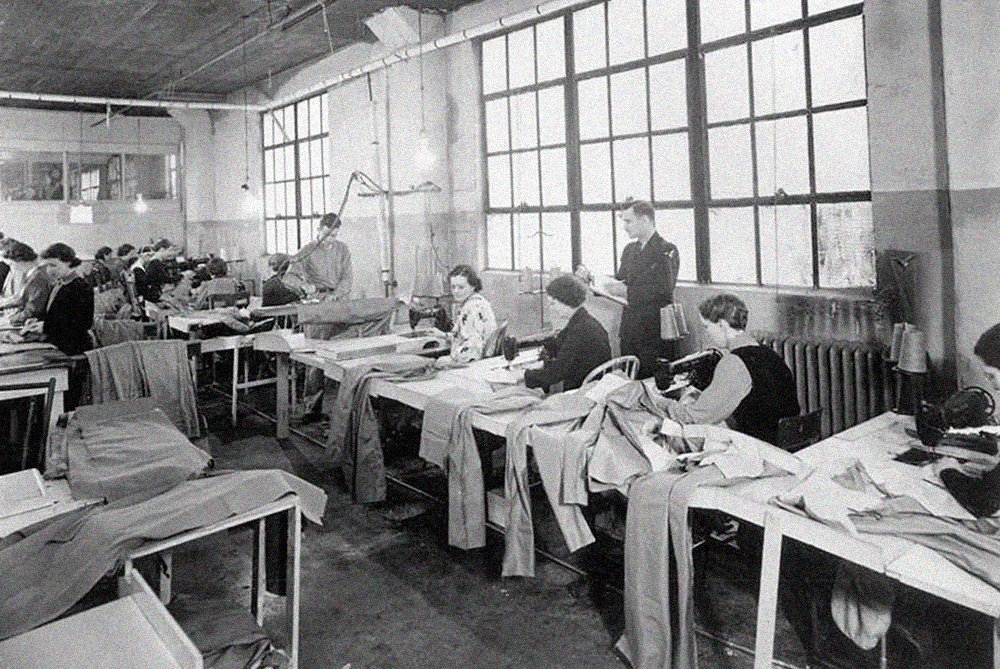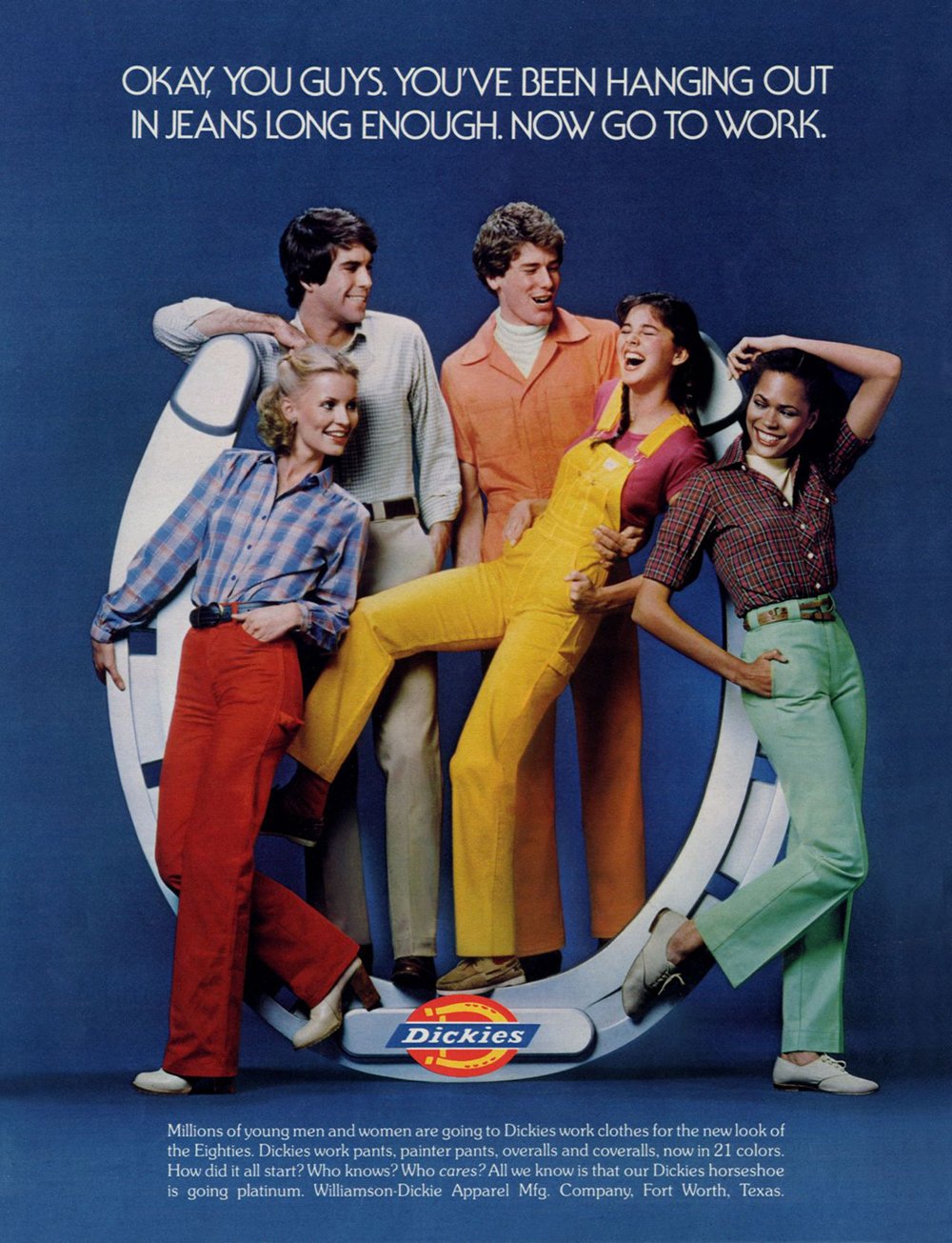100 Years of Dickies
Guess what? Dickies — the company that’s been covering butts, legs, and arms in sturdy, well-fitted fabric for one hundred years — is officially 100!
And to celebrate their 100 years in the business of making fine threads, we’re going to trace the brand’s fascinating and, frankly, unlikely history. We say unlikely because had you gone up to the founders of Williamson-Dickie Manufacturing Company (C.N. Williamson, his son C.D. Williamson, and cousin Col. E.E. Dickie) in 1922 and said, ‘In the future, your pants will be popular with young men that travel about planks of wood fitted with small wheels,’ they would have said, ‘Well, that sounds unlikely.’ But that’s exactly what happened.
Dickies began designing durable clothing for people working in factories, forests, mines, and workshops. That was the starting point. From the get-go, hard-wearing durability was in the DNA of the brand. In time, Dickies tough tailoring branched off into service industry clothing and eventually streetwear, thanks to skaters adopting the brand in the 80s for its indestructibility.
COL. E.E. DICKIE (WITH PIPE) AND SOME MINSTRELS
The 1920s
100 years ago in 1922, E.E. ‘Colonel’ Dickie and C.N. Williamson began manufacturing tough denim bib overalls for workers around the Southwest. Dickies (then Williamson-Dickie Manufacturing Company) were good and tough, and the operation quickly grew. Two years after making their first pair of overalls, the cousins broke ground on a new building in Fort Worth, Texas. 98 years later, Dickies is still headquartered in the same building. Throughout the 1920s Dickies expanded their product line from denim bibs to pants and shirts, and the sewing machines hummed.
The 1930s
The 1930s came and, despite the arrival of the Great Depression, Dickies continued to grow and provide jobs for the country. In fact, they even added a new line to the brand: Don Juvenile. While staying true to the first product they produced, the bib overall, Dickies expanded their offering to reach the entire family. Don Juvenile, was a youth leisure line, an entry-level range to compliment the established workwear brand.
The 1940s
In September 1939, the second World War began, and in 1940 Dickies began work on ‘Soldiers of Supply’ in preparation for America’s involvement. Regular day-to-day work stopped, the company pivoted, and production for US soldiers abroad began. Throughout the war, Dickies produced over 9 million uniforms from their headquarters in Fort Worth, TX. In 1947, after years of wearing the same uniform, soldiers that returned from the war looked for familiarity with their previous day-to-day life. They turned to the same matched set produced earlier in the decade.
The 1950s
When the war ended in 1945, the old decade quickly gave way to the new, and at the dawn of the 1950s returning servicemen had all but re-entered the workforce. ‘Men of Production’ was the largest and most successful campaign at the time for veterans, however, the advertising at the time was not directed to the veteran men, but to their wives, who shopped for the household. Alongside the growth of menswear, Dickies’ Women’s denim grew as well. Workforce women gravitated toward the reliability of the tough pant.
The 1960s
Dickies were always well-designed and always looked good, but in the 60s, the brand began to focus on sartorial elegance in earnest. In 1962, Dickies launched ‘Campus Tigers’, a college campaign centered around the Dickies Slack with no pleats. At the time, these pants had the ability to take the average hopeless nerd and transform him into the coolest guy on campus. Then in the mid-1960s, Dickies embraced the booming car culture with Slack Rallies as a way to connect with the car community.
The 1970s
Entering the 1970s, Dickies became even more popular as a fashion staple, ushering in a new era of colours and prints. Reflecting the design and style of the decade, the workwear brand adapted to the ever-changing world of casual dress and set itself apart. In the late ’70s, Dickies focused on the affordability of their pants using the tag line, ‘We’re Basic’, which wouldn’t work these days, but back then basic was a good thing.
The 1980s
Dickies’ staple pieces from over the decades grew in popularity during the 1980s and took on the 80s colour variations consumers searched for in 80s stores. The iconic overalls, coveralls, and work pants in never-before-seen colours and patterns, and icons of the era —your Madonnas, your Punky Brewsters, your New Kids On The Blocks — helped popularize Dickies with young people even more. But it was towards the end of the 1980s, that really changed the face of Dickies and made it what we know it as today…
The 1990s
By the year 1990, Dickies had been adopted by subcultures on the West and East Coasts of America. Firstly, rap artists — your NWAs, your Snoop Doggs — had taken up the brand for its loose-fitting, taking-care-off-business style. Secondly, skateboarders began sporting Dickies for their durability and style, but mostly durability. When you’re hitting the concrete upwards of 30 times a day, you need tough-as-heck pants, and Dickies could provide it.
The 2000s
In the 2000s, Dickies got back to the root of their heritage: work. While the brand never turned its back on the world’s workers, traditional jobs had drastically changed over the years, but now the brand saw that the time was right to double-dragon on its decades-long pledge to represent workers on the job. And that’s the story thus far. Happy Birthday, Dickies. Here’s to another hundred years of durability and innovation.










